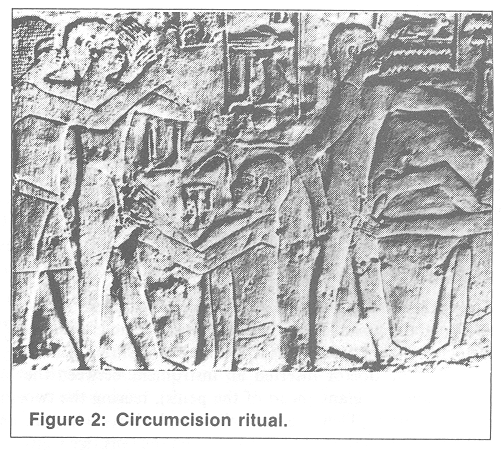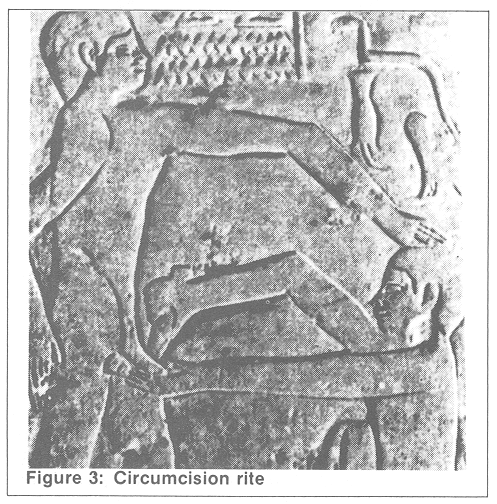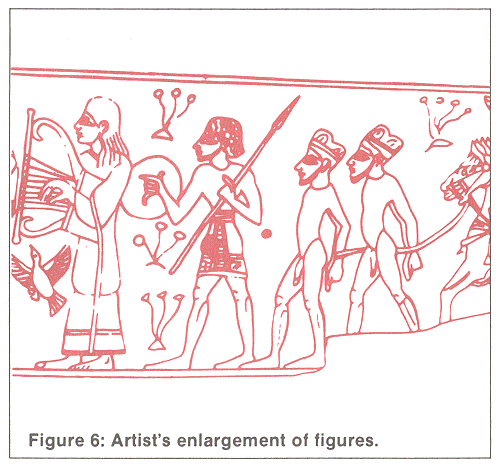Religious Traditions and Circumcision
Gerald A. LaruePresented at The Second International Symposium on Circumcision, San Francisco, California, April 30-May 3, 1991.
The practice of the painful mutilation of the foreskins of infant males in America rests upon biblical and religious traditions plus spurious medical fiction (prevention of penile infection, penile cancer, cervical cancer in partners of uncircumcised males). It is my intention to examine the biblical background for the practice of circumcision.
Just when and why circumcision was first practiced in the ancient Near East is not known, but it was widely attested in antiquity. Bodies from 4000 Before the Common Era (B.C.E.) exhumed in Egypt disclose evidence of circumcision (Breasted, 353, p.10). Ancient Egyptian art, on those occasions when the genitals of Egyptian males were depicted, provide evidence of male circumcision. For example, the carpenter portrayed in a Sixth Dynasty (2350-2000 B. C. E. tomb at Saqqara with his loin cloth pulled to the rear clearly reveals this circumcised penis. (Figure 1)

A relief from the Sixth Dynasty tomb on Ankh-ma-Hor at Saqquara portrays the circumcision of two puberty-aged youths. (Figure 2) A mortuary priest squats on his haunches before one standing youth whose hands are firmly held by an assistant. In the left hand, the priest holds the boy's penis and in the right is what appears to be a circular flint with which he is removing the prepuce. The priest says to his assistant, "Hold him and don't let him faint." The assistant responds, "I will do as you request."

The second youth also stands before a squatting mortuary priest (Figure 3). His left hand rests on the priest's head; the right hand is by his side. He says to the priest, "Thoroughly rub off what is there." The priest who holds the penis in his left hand and is prepared to operate with the large flint knife responds, "I will cause it to heal." Two separate individuals appear to be represented, but it has been suggested that perhaps two stages of the rite of circumcision are being portrayed.

A stele from the 23rd century B.C.E. indicates that Uha, the author, was circumcised in a mass ritual. He wrote:
When I was circumcised, together with one hundred and twenty men, there was none thereof who hit out, there was none thereof who was hit, and there was none thereof who scratched and there was none thereof who was scratched. (Wilson, Circumcision)
The fact that one youth in the Sakkara relief is being held suggests that it was not uncommon for a youth to faint or perhaps to flail violently during the operation. Uha indicates that during the mass circumcision ceremony, the participants reacted without any untoward physical responses. Herodotus, who visited Egypt in the fifth century B.C.E. reported that "they practice circumcision for the sake of cleanliness, for they place cleanliness before comeliness" (II, 37). A mythological reference in Chapter 17 of the Egyptian Book of the Dead states that the sun-god Ra circumcised himself and that from the drops of blood two protective deities came into being, so that perhaps toe was a prophylactic symbolism in the Egyptian practice.
However, not all Egyptians were circumcised. X-rays of the mummy of the Eighteenth Dynasty Pharaoh Ahomse (16th Century B. C. E.) prove that he was not circumcised. It is possible that his successor, Amenhotep I, also was uncircumcised (Harris, Weeks, 126-130). It has also been suggested that although circumcision was common among the upper classes and may be recognized as a puberty rite, it was not a requirement. The poorer common folk did not necessarily undergo circumcision.
Circumcision was practiced by some Semitic groups. Jeremiah in the seventh century, included Edomites, Ammonites and Moabites as among the circumcised (9:25). Assyrians and Babylonians were not circumcised. Nor were the Philistines who are derogatively defined in the Bible as "the uncircumcised" (Jug. 14:3; 15:18; 1 Sam 14:6, etc.) An eleventh century B. C. E. ivory from Megiddo, portrays a ruler seated on his throne between cherubim (Figure 5). Among those in the approaching procession is a soldier leading two nude captives, presumably Semites, both of whom are circumcised. (Figure 6)
Herodotus suggested that other peoples, including the Jews borrowed the custom from the Egyptians (II, 104) but there is no way to verify this statement. Nor is it possible to know for certain just why or how circumcision originally came into being.
Circumcision in the Jewish Scriptures
The earliest reference to circumcision in the Bible is in a folk-tale (written prior to Genesis 17) associated with Moses.
Then it happened at a stopping place along the way that Yahweh met him (Moses) and tried to kill him. Then Zipporah (Moses' Midianite wife) took a piece of flint and cut off her son's foreskin and touched his feet (genitals) with it, saying "You are my blood-bridegroom." So he let him alone. At that time she said "blood-bridegroom in reference to circumcision. (Exod. 4:24-26)

This strange insertion into the tenth century B.C.E. temple fiction about Moses suggests that circumcision became Hebrew custom through contact with the Midianites. Yahweh's demonic intention to kill Moses was magically thwarted by the rite of circumcision performed on the infant son (the beginning of infant circumcision?) Perhaps the reference to "blood-bridegroom" reflects the custom of circumcision before marriage. Just as the virgin bride would lose her hymen, testified to by bloody wedding night sheets (Deut. 22:13-19), the removal of the prepuce would be the groom's parallel loss. Just how the Hebrew word for father-in-law which means, literally, "the circumciser" may be related to pre-marital circumcision is not known. The reference to the use of a flint blade in an age when copper, bronze and iron were known and used, suggests the antiquity of the ritual and may indicate a link to the Egyptian custom of using flint tools for circumcision.
A seventh century B.C.E. reference to circumcision, which also refers to the use of a flint cutting tool, appears in biblical conquest-of-Palestine fiction:
At that time Yahweh said to Joshua, "Make yourself flint knives and squat down and circumcise the people of Israel for a second time." So Joshua made flint knives and circumcised the people of Israel on the hill of foreskins. (Josh 5:2-3)
Subsequent verses form an apologia explaining that the reason the Hebrews had not been circumcised was that for forty years they had been wandering in the desert wilderness. Now, in an ethnic ritual, they would affirm their cultural unity as a circumcised people.
The reference to the squatting or sitting position (based on the Greek Septuagint rather than the Hebrew Masoretic text), the use of a flint tool and the fact of a mass circumcision, once again ties the custom to ancient Egypt. The site of the rite at Gilgal may indicate a hillock where mass circumcision rituals were enacted. Certainly, there could be no significance to a massive pile of foreskins! Although it is not specified, it may be assumed that all males were circumcised at this time both adult and infant.
A still later tradition (post-sixth century B.C.E.) traced Hebrew circumcision back to Abraham. According to his fiction, the deity made a religious-legal covenant with Abraham, the father of the Jewish people, by which Yahweh would be the unique god of the Jews and they would worship him alone. In ancient times, covenants were sealed with marks and symbols; the seal of this covenant was the mark of circumcision:
...for your part you must keep my covenant, you and your descendants ... every male among you must be circumcised. You must be circumcised. You shall cut off the flesh of your foreskin, and that will be the symbol of the covenant between us. Throughout all your generations every male shall be circumcised at the age of eight days ... (Gen 17:10-12)
The regulation included slaves whether Jewish or foreign. Failure to be circumcised resulted in excommunication (17:14)
The Abrahamic covenant, invented by priests, transformed circumcision from an ethnic covenant into a theological divinely ordained legal requirement. It is not a puberty rite nor a pre-marital ritual. It is a covenantal sign to be inflicted on infant males on the eight day after birth to signify their inclusion in the divine promises. Failure to circumcise or be circumcised marks a breach of the covenant.

The story concludes with the 99-year-old Abraham circumcising himself, his son Ismael, who was 13 years old, and all male members of his extended household. A year later, when 90 year old Sarah bore Isaac, Abraham had the boy circumcised on the eight day. (Gen. 21:4).

During the last quarter of the fourth century B.C.E., Alexander the Great conquered the ancient Near East and he and his successors introduced Greek customs and culture into the expanded empire. One of the innovations was the gymnasium. The Greeks did not circumcise and when young Jews enamoured by Greek customs and culture, entered the Gymnasium where exercises were performed in the nude, they were embarrassed when their physical deformity became apparent. To conform they underwent a decircumcision process. The Maccabean report, which was written about 100 B.C.E. reads:
The Jewish historian Josephus, who wrote during the late first century of the Common Era (C.E.), commented:They constructed a Gentile-style gymnasium in Jeruselem. They also pulled forward their prepuces thereby repudiating the holy covenant (1 Macc. 1:15)
...they also hid the circumcision of their genitals, that even when they were naked they might appear to be Greeks. (Antiquities, XII, v.l)
Dependent upon how completely the foreskin had been removed, it was possible to cut and pull forward the loose skin of the penis (epispasm) to form a partial foreskin. However such an act, as the author of Maccabees noted, constituted a denial and rejection of both their circumcision heritage and their Jewish heritage thereby placing such a person outside the covenanted community. As we shall see, much later, when Christianity developed, the reversal of circumcision, while no longer common, was apparently still practiced.
Anti-Judaism became a major issue under one of Alexander's successors named Antiochus IV, who ruled Judea from Syria. He forbade circumcision and his agents killed those whose infants were circumcised together with the circumcised baby (I Macc. 1:48, 60f). After a bitter struggle, the Jews experienced a brief time of freedom before they came under Roman domination.
Interestingly enough, toward the end of the second century B.C.E., when the Jewish prince Hyrcanus invaded and conquered Idumia, he offered the Idumenas a choice: to be exiled or to become Jews. They chose the later, were circumcised, and thus became instant Jews. They were not truly accepted by traditional Jews, and when Herod the Great - the strongest Jewish ruler - assumed the throne, his Idumean background earned him the label of "half-Jew." Circumcision was not enough.
Other reasons for circumcision that were advocated by Jewish Philosophers were to curb sexual desire. Philo, an Alexandrian Jewish Philosopher, born in the last quarter of the 1st century B.C., justified circumcision to reduce sexual desire since engaging in intercourse for pleasure was being "like pigs and goats; and Moses Maimonides in The Guide of the Perplexed taught that circumcision would "bring about a decrease in sexual intercourse and a weakening of the organ in question" ... and that "The bodily pain caused to that member is the real purpose of circumcision (Part III, Chapter 49).
Circumcision in the Christian Scriptures
The first Christians were Jews and were therefore circumcised. The Gospel of Luke reported that Jesus was circumcised on the eight day (2:21). The apostle Paul was also circumcised on the eight day (Phil. 3:5). As the Christian church began to move out into the Mediterranean world and attract non-Jews, circumcision became a problem for converts. The issue came to a head (no pun intended!) in the Galatian controversy.
Paul established new Christian groups in the Greek world. His pattern seems to have been as follows: he would speak in a Jewish synagogue concerning the end of the age and Jesus as the Christ and means of salvation. Some Jews would listen; others rejected him. Among those attending the synagogue were non-Jewish Greeks, attracted perhaps by the monotheistic faith and ethical ideals. Some were drawn to Christianity but, when they wished to join the new group, they were informed by the conservative elements in the church that before they became Christians they had to become Jews and be circumcised. Paul saw this demand as a stumbling block inasmuch as adult male Greeks had no intention of being circumcised. Therefore he wrote to the Christian church he founded in Galatia.
In this letter he challenged the validity of circumcision as a criteria for membership in a Christian church. He castigated the leaders in Jeruselem. He pointed out that Cephas (Peter) had been two-faced in the matter by swaying to the conservative side when confronted by the circumcision party after agreeing that Paul's mission was to the circumcised (sic) (Gal. 2). Paul argued that "in Christ Jesus neither circumcision nor uncircumcision count for anything" 5:6, and he expresses the wish that for members of the circumcision party the circumcision blade might slip and more than the foreskin be removed so that they might "mutilate themselves" (5:12).
The same issue seems to have surfaced in the city of Corinth. Paul wrote a letter to this group in which he stated:
Was anyone already circumcised when he was called (to be a Christian)? Let him not seek to remove the marks of circumcision. Was anyone circumcised when he was called? Let him not seek circumcision. (I Cor. 7:18)
Obviously, there were some who sought to disavow their Jewish heritage by removing the mark of circumcision, just as their ancestors had done during the time of the Maccabees. For Paul neither circumcision nor uncircumcision counted for anything. Ultimately the matter was referred to the Jeruselem council where after serious debate, it was decided that circumcision was not a requirement for membership in the Christian community (Acts 15).
Conclusion
For present day Jews, circumcision is both a covenant rite and a naming ceremony. Orthodox Jews follow ancient practices. On the eighth day, the infant son is taken to the Mohel (the circumciser) for a rite performed according to the a primitive ritual. The blood flow is stopped by wine, held in the Mohel's mouth - a custom which some Jews find revolting. These believers are fulfilling Torah requirements. Non-orthodox Jews may have their sons "done" in a hospital setting. Even Jews who have moved away from Judaism toward a secular life or humanistic way of life, continue to have their sons circumcised. Christians, too, have their male offspring circumcised in some cases because Jesus was circumcised but far more often in an unthinking, uncritical way as something that is done to newborn males. As better information regarding circumcision is circulated, outmoded beliefs concerning medical or health benefits will be discarded. Only ancient beliefs will remain as a stimulus for the continuation of this barbaric custom.
References:
Breasted, James H. (1933) The Dawn of Conscience, N.Y., Scribner.
Bullough, V. (1976): Sexual Variance in Society and History.
Wiley: Interscience, New York.Harris, James E. and Weeks, Kent R. (1973): X-raying the
Pharaohs. Scribners, N.Y.Maimonides, Moses (1963): The Guide of the Perplexed, (Shlomo Pines, Trans) Vols. I & II,
University of Chicago Press, Chicago.Wilson, John (1950): Circumcision in Egypt, in James F Pritchard,
edit, Ancient Near Eastern Texts Relating to the Old
Testament, Princeton University Press, p. 326.
Dr. Gerald Larue is professor emeritus of Biblical history and archeology at the University of Southern California and chairman of the Committee for the Scientific Examination of Religion. A prolific author, Larue's books include Ancient Myth and Modern Man, Sex and the Bible, Euthanasia and Religion, and most Recently, Ancient Myth and Modern Life. He is the recipient of the American Humanist Association's 1989 Humanist of the Year Award.
This article first appeared in The Truthseeker, July/August 1989, pages 4-8.
